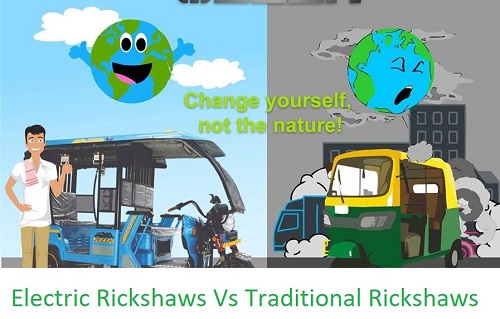Rickshaws are an ordinary mode of transport, primarily in crowded cities and towns. They have become a very cost-effective and efficient way of transporting people or goods over short distances. However, as the size of the cities grows, so does the environmental concern, and here is born the concept of a new type of rickshaw: electric rickshaws. Why is the shift from a traditional to electric rickshaw important?
In this essay, we’ll compare the two and explain why making the move is important for the environment.
Understanding the Traditional Rickshaw
Formerly, these were driven by either human or animal force. Still, today only a few rickshaws operate on relatively modest gasoline or diesel motors. Conventional rickshaws are still in strong demand for short excursions in urban centers. They are particularly in densely populated areas where larger vehicles are not viable.
How they work
Conventional rickshaws use mainly petrol or diesel engines. These are intended to transport passengers and, in certain situations, commodities. These rickshaws are still inexpensive and can handle small roads and congested streets.
Environmental concerns
These rickshaws have considerable negative environmental consequences. They emit toxic pollutants, which lead to bad air quality. Moreover, they depend on fossil fuels that will eventually consume themselves and become too expensive to use.
Electric Rickshaws: The New Alternative
These vehicles are an unique alternative that replaces conventional rickshaws. Each day, urban areas get more dirty, and transportation issues worsens. In such circumstances, electric rickshaws flourish. These do not burn gas but rather operate on electric motors. To run the motor, they use rechargeable batteries.
How they work
They use batteries that are rechargeable. This makes them more environmentally friendly. These kinds of batteries may be charged using any standard electrical socket. Many e-rickshaws may go up to 80-100 kilometers on a single battery charge, subject to the model and operating conditions.
Environmental advantages
They generate much less carbon than conventional rickshaws. They do not emit harmful compounds such as carbon dioxide or nitrogen oxides, reducing air pollution in densely populated areas. This move helps to create cleaner cities and a better environment.
Key Differences Between Electric and Traditional Rickshaws
Let’s look at the important differences between electric and traditional rickshaws.
Fuel and Emissions
Traditional Rickshaws
Conventional rickshaws operate on petrol or diesel, emitting toxic emissions. The resulting emissions contaminate the environment while having an impact on it. It emits greenhouse gasses as well as potentially harmful elements into the natural environment.
Electric Rickshaws
E-rickshaws, on the other hand, rely on power. They create no exhaust from the tailpipe, thus rendering them significantly more environmentally friendly. The main advantage of converting to electric rickshaws is a decrease in air pollution.
Fuel Cost
Traditional Rickshaws
Petrol and diesel prices vary. This typically ascends during specific seasons. Traditional rickshaws demand frequent refilling. It may be costly for the drivers, particularly in cities with high gasoline rates.
Electric Rickshaws
The automobiles are run using batteries that are rechargeable. They cost substantially less to be refilled than gasoline or petrol.Although the starting Electric Auto Price is greater, the long-term energy savings make it more economical for the driver as well as the passenger.
Maintenance
Traditional Rickshaws
Conventional rickshaws feature sophisticated internal combustion engines. It needs routine maintenance such as oil changes, spark plug replacements, and air filter cleaning. As time passes, maintenance fees might accumulate.
Electric Rickshaws
It possesses fewer moving components than typical rickshaws. This implies that they need less upkeep. They don’t require oil changes or spark plug replacements, which reduces maintenance expenditures.
Noise Pollution
Traditional Rickshaws
Gasoline and diesel engines are loud. They add to noise pollution in cities. This may be disturbing, particularly in heavily populated areas.
Electric Rickshaws
Electric motors are substantially quieter than those powered by combustion. It enables electric rickshaws, an excellent choice for decreasing noise pollution. This makes cities more appealing to both the people and tourists.
Why the Shift Matters
The transition from conventional to electric rickshaws is more than simply a desire. It has enormous environmental, economic, and social consequences. Here’s the reason why the shift is important.
1. Lower Air Pollution
Adopting electric rickshaws may drastically reduce air pollution. Cities with large populations, especially those in developing countries, are suffering increased levels of air pollution. Traditional rickshaws add to the situation. Cities that use electric rickshaws may significantly reduce hazardous emissions. It also enhances air quality, resulting in greater health for people.
2. Sustainable Transportation
They offer an ecologically sound transportation solution for the years to come. Electric rickshaws connect with worldwide initiatives to increase renewable energy and reduce dependency on fossil fuels. They form a component of an ongoing drive to build eco-friendly and sustainable cities. The rickshaws are a cleaner, more efficient solution to traditional fuel-powered vehicles.
3. Economic Benefits for Drivers
Shifting to electric vehicles can save rickshaw drivers money on their operational costs. Traditional rickshaws require frequent refilling, which accumulates over time. Electric rickshaws, on the other hand, are far less expensive to recharge. Electric rickshaws also have cheaper maintenance expenses, which contributes to total savings. Therefore, electric rickshaws are an increasingly economically feasible choice for drivers over time.
5. Challenges and Considerations
Since rickshaws have several advantages, there are certain barriers to their implementation. The E rickshaw price on road is affordable and they may be more than a regular one. However, this cost is frequently mitigated over time due to cheaper fuel and maintenance expenses. Furthermore, charging infrastructure must be established, particularly in rural and isolated locations. This makes electric rickshaws a realistic alternative for everyone.
Conclusion
The switch from conventional to electric rickshaws is an initial move toward healthier, greener cities. Electric rickshaws have a lesser environmental effect, cheaper operating costs, and increased energy efficiency. E-rickshaws are going to take an increasingly important part in transportation as they become increasingly available and inexpensive. The transition to electric rickshaws advances us toward a greener, more sustainable future, serving both drivers and passengers.










